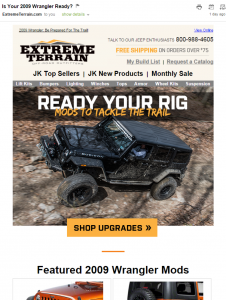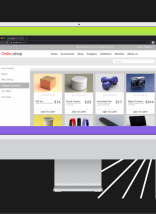It’s no secret that eCommerce is both extremely successful and extremely competitive. How does a site gain market share, loyal customers and revenue? It may seem mystical — lots of smart people have created good sites and not been successful.
The example I will use to illustrate the 10 critical elements is www.extremeterrain.com. I happen to also be an off-road enthusiast and this site caught my attention by how well it is put together. Our company didn’t build the site and we aren’t affiliated with it at all. It is impressive work, however.
This post doesn’t deal with anything related to marketing or actual fulfillment or customer service. Let’s assume that you won’t be successful if nobody comes to your site or you deliver really lousy service. Agree?
As you read through this list you notice a consistent theme. Trust. People very rarely do business with anyone they don’t trust. Most of the keys to successful eCommerce are related to establishing trust with the consumer. Trust in the company and trust in the product.
1. Precise, Targeted, Unique Emails on a Regular Schedule
Successful e-commerce sites use e-mail. A lot. So what’s different? Lots of people use spammy communications to try and drum up business for everything from drugs to Groupon specials.
Successful e-commerce mailing appears in your inbox as something very interesting and targeted specifically for you. Looking at the email below you will notice how many times they use the information they gathered about me to precisely target the email. “2009 Wrangler” is used in the subject, the header, and the sub-heading above the targeted product listing. Exciting Wrangler imaging is, of course, also used as the primary e-mail image.
 2. Big, Detailed, Consistent Pictures
2. Big, Detailed, Consistent Pictures
One of the things that makes customers hesitate to buy, even if they think they want the product, is a lack of confidence about the quality or whether it’s really exactly what they want. Having big, detailed, consistent pictures closes the gap from an in-store experience significantly and increases the buyer’s confidence that it’s what they are looking for. Where all the other sites simply have decent picture of the product. Extreme Terrain goes way above. They actually install the products on a Jeep and show how they look. In addition they allow their customers to post photos of their rigs with the products installed. It’s a home run. Who doesn’t want this parked in the garage?


3. Clear Descriptions
Just like having big pictures, clear descriptions help buyer to understand what they are really getting. This lessens their concern they are going to get something they don’t want. It doesn’t matter whether they can ship it back or not, most people don’t want to hassle with the process.
ExtremeTerrain provides 4 different tabs with detailed information about the product so the customer knows exactly what to expect.

4. Targeted Focus
Ok, let’s face the facts. This post isn’t about creating Amazon.com. Unless you have a spare billion and think you’re smarter than they are, you should probably choose a niche and stick to it. Once you choose that niche make sure it’s big enough that you can focus precisely on it without expanding in order to grow your revenue. Once you lose focus, you’re out in the tall grass without a GPS.
Extreme Terrain isn’t just about 4×4 parts in general. It is specifically about Jeep Wranglers. They probably have a mission statement somewhere about being the most complete and most trusted online resource for Jeep Wranglers anywhere. Small enough to get their arms around, but big enough to do one heck of a lot of business.
5. Real Reviews
Consumers can spot a fake review a thousand miles away. Fake reviews detract from trust and detract from conversions. Data actually shows that bad reviews boost sales. Read about it here (http://hbr.org/2012/03/bad-reviews-can-boost-sales-heres-why).
The point is that reviews increase confidence and increase trust and that increases sales. Seeing a pattern here?
Look how well Extreme Terrain does at displaying reviews. They are also in the main part of the page, near the add to cart and pricing. There are stars all over the page. Of course in order to display reviews you also have to be good at capturing reviews and enticing customers to leave them.

6. Clean Design, Organized Navigation
Don’t make your customers work to find what they are looking for. Good user experience is a must. You can get away with a few mistakes but once a user feels like it’s a struggle to get around then they associate the difficulty of the shopping experience with frustration and other negative thoughts and as you can probably imagine this doesn’t lead to happy customers.

7. Good Search
What makes a good search? First it should be prominent and easy to find. Second, the search should be contextual so search terms are suggested as you type. Third, the search catalog should contain all of the site’s pages; products, blogs, and static/informational. Finally, when the search results contain products the site should display images, descriptions, price, and reviews. It isn’t essential but having the ability to refine and sort the results further by price, category, manufacturer, rating, etc. is a nice feature.
Search has less to do with trust than some of the other items and more to do with common sense. If your customers can’t find what they are looking for then they can’t buy it. Duh. In addition, many merchants fail to capture internal search data so they can see what customers are looking for and perhaps not finding. It helps guide product selection, trends, and even promotions. Google Analytics makes it really easy to wire up so there’s no excuse.

8. Subject Matter Experts / Accessible Customer Service
Going back to trust again. Trust in the product and trust in the company. The more you can help customers to feel confident in what they are purchasing the more they will purchase. Sometimes the mere appearance of accessibility to customer service and focused expertise is enough.

9. Affordable Shipping / Simple Return Policy
People don’t like to pay for shipping because it feels like “tax.” To some extent they don’t mind paying for expedited shipping to get it faster because that’s a choice. I’m no saying shipping should be free, but whenever you can offer free shipping options that’s a huge bonus. Many sites have a minimum order value where shipping becomes free. This has a huge effect on improving the average order size.
The return policy goes back to trust again. The buyer’s threshold for confidence must be much higher if “all sales are final.” Conversely if you offer a simple, easy return policy customers will consider slightly more risk. Additionally more trust is created if you appear willing and eager to help customers if they are less than satisfied with their purchases. Mostly common sense.

10. Mobile Experience
This simply comes down to data. Lots and lots of customers do their shopping and browsing from mobile devices and tablets. These numbers continue to grow, although slower than they have in the past. It is near suicidal to provide a poor mobile experience to your customers.
Conclusion
As you can see, a lot goes into a solid, high-performing eCommerce website. And while it can look overwhelming, the end result is an eCommerce engine that will drive your business in ways you might never have imagined before. Ready to go further with eCommerce? Learn more about how we can help with your eCommerce needs and contact us to talk with an eCommerce expert ready to help you take your business to the next level!







